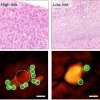A team from Massachusetts General Hospital has developed new technology that converts a smartphone into a tool for cancer diagnosis. The approach, called D3 (digital diffraction diagnosis), consists of a dongle that sits on top of the phone’s camera and specially designed microbeads that bind to cancer cells that can then be imaged using the phone.
The microbeads are coated with antibodies that target specific cancer types, while the shape of the beads determines how they diffract light. Thanks to the optical components and the LED light within the dongle, the system is able to capture tens of thousands of cells in a sample in one shot. Once that’s done, a special app developed just for this purpose analyzes the image taken, quantifying the light returning from the sample and converting that into an indicator of the chance of the presence of cancer.
D3 analysis of fine-needle lymph node biopsy samples was accurately able to differentiate four patients whose lymphoma diagnosis was confirmed by conventional pathology from another four with benign lymph node enlargement. Along with protein analyses, the system was enhanced to successfully detect DNA – in this instance from human papilloma virus – with great sensitivity. In these pilot tests, results of the D3 assay were available in under an hour and at a cost of $1.80 per assay, a price that would be expected to drop with further refinement of the system.
“We expect that the D3 platform will enhance the breadth and depth of cancer screening in a way that is feasible and sustainable for resource limited-settings,” says Ralph Weissleder, MD, PhD, director of the MGH Center for Systems Biology (CSB) and co-senior author of the paper. “By taking advantage of the increased penetration of mobile phone technology worldwide, the system should allow the prompt triaging of suspicious or high-risk cases that could help to offset delays caused by limited pathology services in those regions and reduce the need for patients to return for follow-up care, which is often challenging for them.”
Source:Rice University
Massachusetts General Unveils Smartphone Device for Diagnosing Cancer

